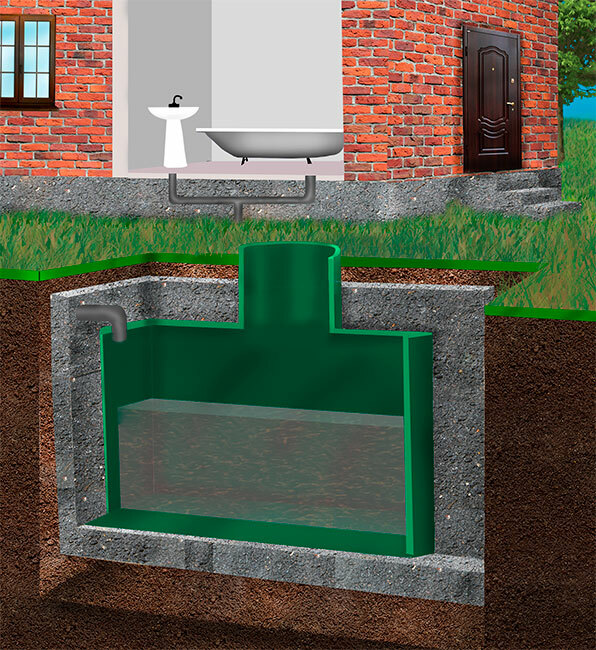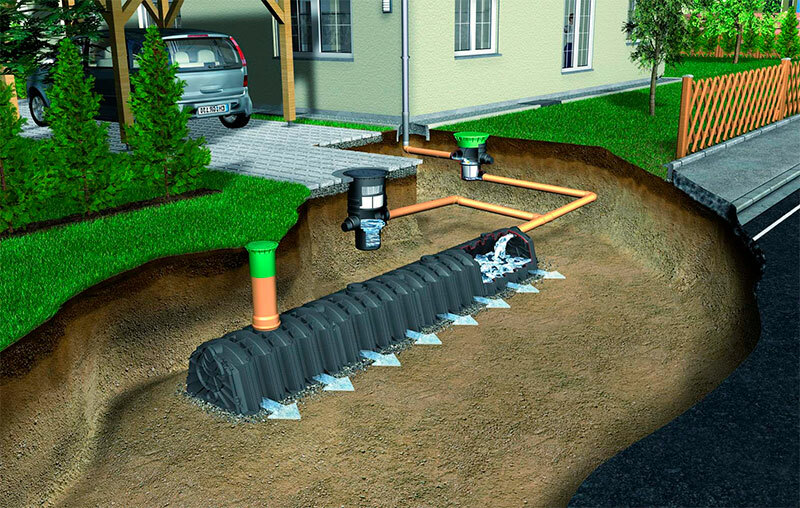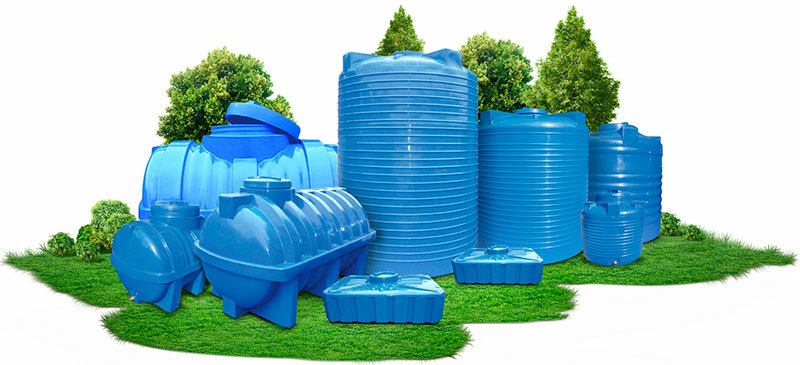In many private houses there is no connection to the central sewerage system. In order not to lose all the benefits of civilization, people create autonomous sewerage systems. A septic tank is a reservoir where domestic and domestic water flows. Depending on the model, the structure can act as a storehouse or filter drains. In any case, septic tanks protect the soil from pollution and preserve the ecological cleanliness of the site. You will learn how to choose a septic tank in this article.

Contents:
- Best producers of septic tanks for private houses
- Principle of operation and device for septic tank for private house
- Varieties of septic tanks for private houses
- Options for selecting a septic tank for a private house
- Which septic tank for a private house to choose
- How much does a septic tank for a private house
? Best manufacturers of septic tanksfor private houses - which firm to choose
The production of septic tanks arose not so long ago, but there are already quite a few companies that specialize in this field.
Many firms produce copies of the best brands, but the following manufacturers have created truly unique designs:
1. Triton-Plastic
2. Topol-Eco
3. Eco-Grand
4. FloTenk
These companies took the dominant positionin the market of cleaning systems, due to the optimal quality-cost ratio, as well as a wide range of septic structures. Also, the designs are easy to operate.
If you are interested in knowing which models of septic tanks are considered the best, read this article.
Principle of operation and device septic tank for a private house

The structure is a container made of waterproof, high-strength material.
There are simple and complex installations. The former serve as a sealed reservoir for the accumulation of sewage. The second inside can have several chambers. The filtration system in them consists of several stages:
1. Defending household waste water
There are several chambers inside the device, in the first( settling tank) the drains come directly from the sewage system. At this stage, waste water settles from solid particles.
2. Filtration with anaerobic bacteria
At this stage, water enters the second compartment by a pump or by a natural design. Bioenzymes purify effluents from traces of vital activity, forming sludge, gas fraction, as a result of which water is clarified.
3. Cleaning with the
filtration well In the last section, the water is finally filtered by perforated walls and a drainage layer and absorbed into the ground.
Septic tanks are used if there is no possibility to connect a private house to the central sewer.
Unlike a cesspool, this structure has significant advantages:
- drains are processed using a natural biological method of cleaning, so do not pollute the soil;
- longevity;
- no unpleasant odor in the private house;
- the possibility of filtering a large number of drains and, as a consequence, the lack of the need for frequent maintenance of a sewage machine.
Types of septic tanks for private houses
Depending on the location and form of the septic tank, there are horizontal and vertical ones. The first are a tank with several sections. Such devices are suitable for installation on sites with a high level of groundwater, but require a large area of land and a shallower depth of the excavation. The second is like a barrel with a hatch. The installation requires a smaller area and a rather deep pit.
By the type of location of the cameras there are surface and underground cleaning plants. To install the first requires a minimum of financial costs and time. Such septic tanks are excellent for HUVV and a small amount of drains. The second ones come from one or more cameras and are built on the principle of a modular system. They are great for private houses with daily living.
According to the principle of operation of the device are as follows:
Cumulative

Such devices are a sealed reservoir in which waste water accumulates. After full filling of the tank, it is necessary to pump the sewage with a sewage machine for further utilization. Storage facilities can have different capacity: from 1 to 40 cubic meters. Some models are equipped with special sensors that indicate the fullness of the septic tank, as well as ribs for additional strength. Storage tanks are recommended to be installed in areas that are not intended for living all year round, for example, the country private sector or in private houses with a small average daily volume of wastewater.
Advantages:
- ease of use, installation;
- septic tank prevents soil contamination, therefore it is an excellent alternative to a cesspool;
- the minimum service life of a plastic septic tank is about 30 years;
- durability of construction.
Disadvantages:
- , as filling becomes necessary to clean the sewer machine;The
- system does not purge the drains;
- , the freezing of effluents inside the storage tank must not be allowed.
With soil filtration

The principle of operation of devices is not just the accumulation of effluents, but also their filtration and subsequent disposal of purified liquid into the soil. Such plants also require the services of sewers( a dense solid precipitate formed after the filtration of effluents accumulates over time), but much less, as a rule, not earlier than 3 years of regular use. The cleaning efficiency is 65-85%.Installations are recommended for private houses with permanent residence and regular use of water.
Advantages:
- non-volatility;
- high-quality wastewater treatment;
- saving on sewerage services.
Disadvantages:
- septic tanks are not suitable for installation on clay soil, in areas with high groundwater;
- complex installation;
- high cost.
With deep bio-cleaning

Such models are great for those who care about the state of groundwater and soil. Devices recommended to install with a large volume of daily drains. Many owners of similar devices install additional tanks for purified liquid as a saving and use it in the irrigation system.
Advantages:
- cleaning efficiency up to 98%, therefore the treated effluent can be discharged into a pond or reused;
- slow accumulation of sludge, so you have to turn to sanitation for 6-8 years;The
- is suitable for installation on all types of soils.
Disadvantages:
- volatility;
- high price.
Options for selecting a septic tank for a private house

When choosing a septic model, a complete analysis of the model, its technical and operational characteristics should be carried out:
1. Capacity
The choice of the purification system must be based primarily on the correct calculation of its volume. Installation of inappropriate design and incorrect calculation is fraught with malfunctions in the sewerage system or financial costs associated with frequent maintenance of the sewage machine.
2. Type and number of septic tanks
According to the principle of operation, septic tanks are accumulative, with soil filtration and with deep bio-purification, and septic tanks are one-, two-, three- and four-chamber. The user must take into account all the advantages and disadvantages of each model and choose the best option for his private home.
3. Housing material and wall thickness
These characteristics directly affect the cost of the structure. Septic tanks are made of metal or plastic. Depending on the material, volume and diameter of the septic tank, the average thickness of the walls is 5-20 mm.
4. The location of the
can be vertical and horizontal.
Poorly treated effluents harm the environment, so that there are no problems with sanitation, when choosing a septic tank for a private house, the following factors should be taken into account:
- from the bottom of the filtering structure to groundwater should be at least 1-2 m;
- if the soil is poor in absorbency, then it is better to use special biofilters.
Which septic tank for a private house to choose

1. The volume is of paramount importance, therefore the choice should be made depending on what daily average amount of drains the system will have to process every day. When choosing the capacity, it is necessary to take into account the number of people living in a private house, the availability of sanitary equipment, soil characteristics and water consumption by guests.
Below are the data for an approximate calculation of a two-, three-section septic tank:
- 2-3 residents - up to 2 cubic meters;
- 4-5 residents - 4 cubic meters;
- 6-7 residents - 6 cubic meters.
2. If the family is taken to take a shower all the time, there is a washing machine, a water heating tank, a dishwasher, etc., then the average daily volume of consumed liquid increases significantly.
3. To reduce the costs of sewerage services, it is better to choose septic tanks with a large capacity. But it should be borne in mind that the cost of such installations is quite high, so it is worthwhile to purchase them if you live in a private house on a permanent basis.
4. To ensure that the cleaning system is not damaged during installation, the septic design must be made of high-strength material. In addition, most of the time the septic tank will be empty, and it will be affected by serious soil pressure.
The most common materials are as follows:
- Plastic septic tank is resistant to moisture and chemicals, high strength, but at the same time it is a rather brittle material. There are polyethylene( not suitable for storing hot liquids, sensitive to sharp objects, less durable, but more affordable), polypropylene( harder and more abrasion resistant, but more expensive), fiberglass( considered to be the strongest, based on resin, forglass fiber reinforcement is added to the walls).Plastic devices are quite popular and, despite the shortcomings, have more advantages than metal ones.
- Metal tanks are used less often. This is due to the corrosion of the metal, even with anti-corrosion coating. The life of such products does not exceed 20 years, so buying them is not recommended.
5. During a seasonal stay in a private house, a full-fledged sewage treatment system is not required at all. It is much easier to install a simple cumulative septic tank. In addition, the cost of such a design is much smaller than more complex models. With a permanent residence it is better to choose septic tanks with several sections.
6. With regard to the location and form of the septic tank, it should be selected based on the following factors:
- if the groundwater table is elevated, it is advisable to install a horizontal septic tank;
- vertical models are suitable if there is a need for a compact arrangement of the cleaning system.
7. For those who live permanently in a private house, septic tanks with soil filtration or deep bio-cleaning are suitable. Both devices filter drains, but the level of purification is somewhat different, if this difference is not important, then it is better to choose a structure with soil filtration, it is somewhat cheaper and does not require the presence of electricity.
How much is a septic tank for a private house?

The cost of septic tanks depends on the model of a particular installation, material and volume.
Average cost of plastic septic tanks:
1. Cumulative 2000 liters - 24000 rubles;3000 liters - 40000 rubles;4000 liters - 81000r.
2. With soil filtration 2000 l - 59000 r.; 3000 liters - 70000 rubles.;4000 l - 90000 r.
3. With a deep biofeedback of 1 cubic meter / day - 98000 rubles;3000 m3 / day - 160000 p.
4. The average price for a metal cumulative septic tank is 34,000 rubles.
When buying a septic tank, you should take into account not only the cost of the device, but also the subsequent costs: the frequency of maintenance of the sewage machine, installation work, the need for additional cleaning products.
